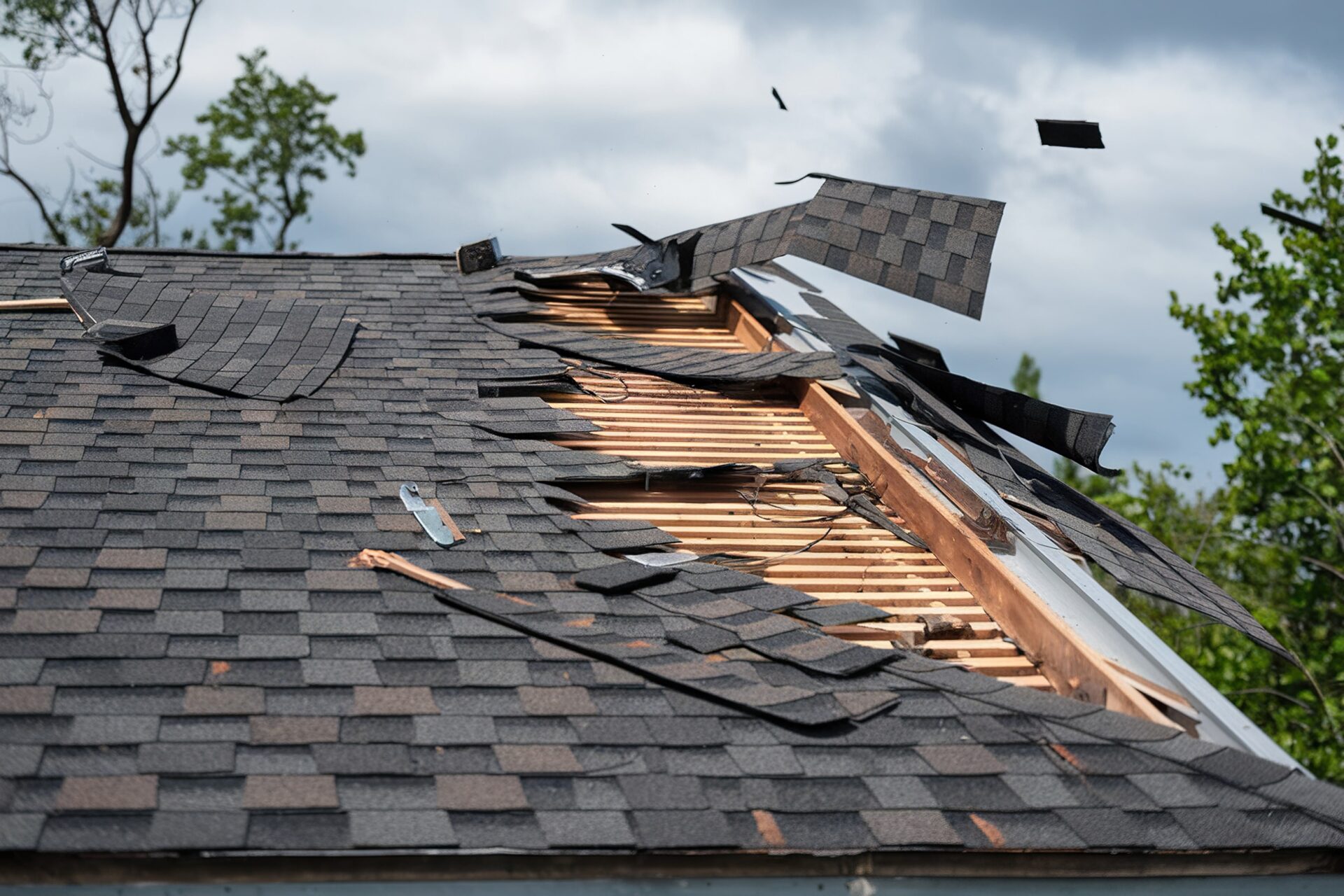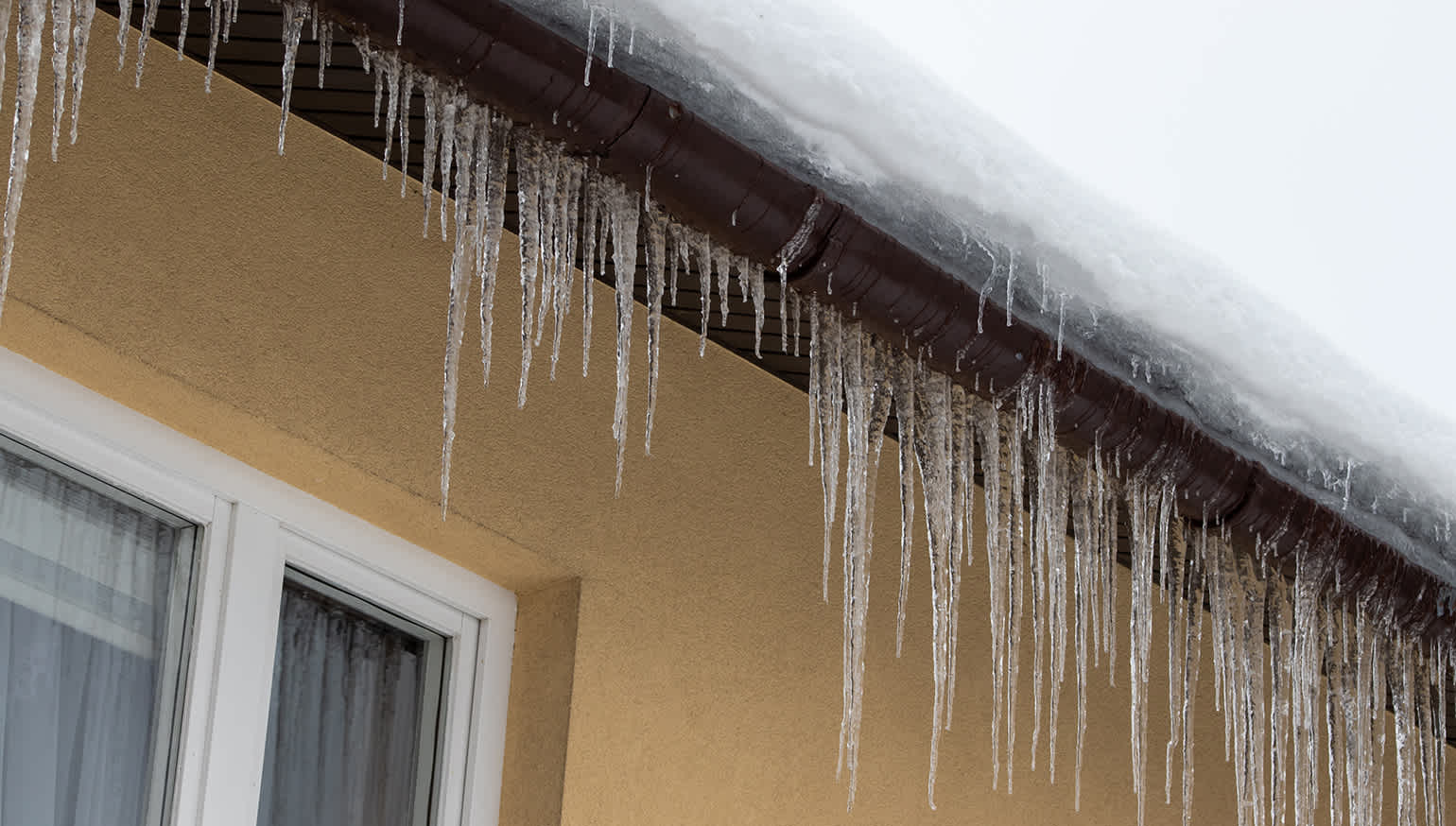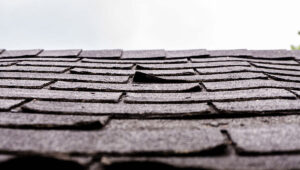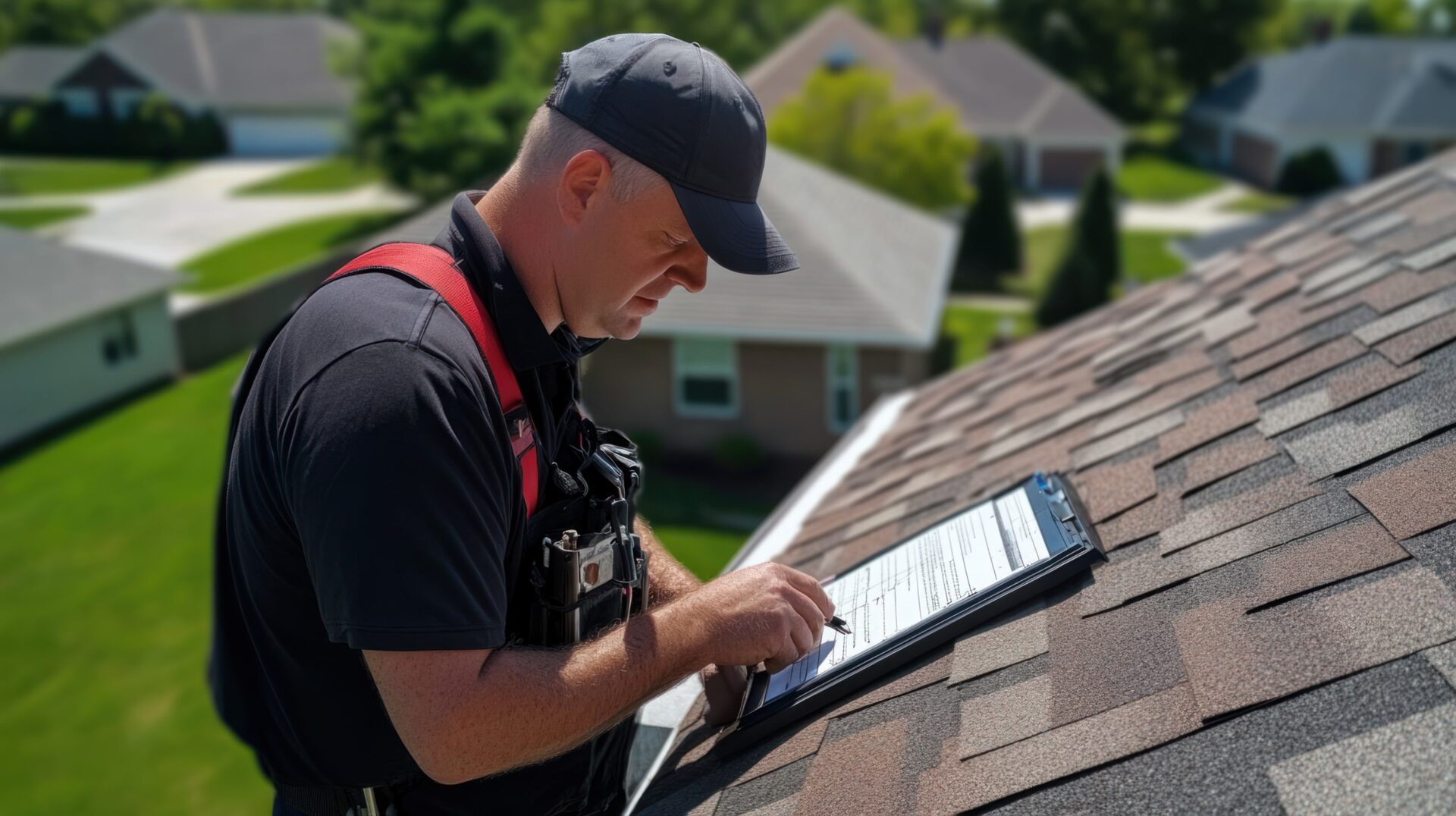Across Coeur d’Alene and Spokane, homeowners and property managers are facing mounting pressure from the insurance industry: upgrade your roof, or risk losing coverage. This is especially urgent for property management companies overseeing single-family rentals, as well as homeowners who may be unaware of the full scope of their roof’s condition or the financial support options available to them. Insurance carriers have begun sending out warning letters, urging action before the next major weather event strikes.
In this blog, we’ll walk you through how to identify storm damage on your roof, from subtle signs like granule loss and cracked shingles to more obvious issues caused by hail or wind-driven debris. We’ll explain how these damages impact the long-term integrity of your property and provide a step-by-step look at how to conduct an inspection—safely and effectively—or when to bring in a qualified roofing contractor. You’ll also learn what to do if damage is found, including tips for filing an insurance claim and exploring available financing opportunities for necessary upgrades.
Whether you’re a property manager overseeing rental units or a homeowner navigating unfamiliar insurance demands, this guide is designed to help you stay ahead of the curve. By acting early and understanding your options, you can protect your Coeur d’Alene property, maintain compliance with insurance requirements, and avoid costly repairs in the future.
Key Takeaways
- Property owners should inspect for subtle signs of storm damage, including missing shingles, granule loss, and hail impact, to prevent further issues.
- Addressing collateral damage to gutters, siding, and windows after a storm is essential for maintaining the overall integrity and value of the property.
- Effective communication with insurance providers and organized documentation are crucial when filing claims for storm-related roof damage.
At Russell Quality Roofing, we take pride in delivering premium roofing services with integrity, professionalism, and exceptional craftsmanship. Proudly serving Lewiston, Clarkston, Pullman, Moscow, Spokane, Liberty Lake, Post Falls, Coeur d’Alene, and surrounding areas, our certified professionals bring over 17 years of experience to every residential and commercial project.
Whether we’re installing shingles on a new home or replacing a roof on a commercial building, we uphold the highest standards of quality and care. From free estimates and detailed planning to expert installation and comprehensive warranties, we prioritize cleanliness, organization, and communication throughout the entire process. As an Owens Corning™ Platinum Preferred Contractor, we are among the top 1% of professional roofers nationwide—trusted, award-winning, and built on long-standing client relationships. Contact us today at (208) 791-5252 for your FREE estimate and experience roofing the Russell way.
Types of Roof Storm Damage Every Property Owner Should Know in Coeur d’Alene and Surrounding Areas

Not all storm damage is immediately obvious, but over time, even minor wear can escalate into major structural issues. Whether you own a home or manage a commercial building, being able to recognize the various types of storm-related roof damage is the first step toward timely repairs and effective insurance claims. Below are the most common types of roof damage caused by severe weather events in Coeur d’Alene and the surrounding areas.
Wind Damage
Strong wind gusts, particularly during late spring thunderstorms or summer storms, can lift shingles, tear off flashing, or even detach entire sections of the roof in extreme cases. In Coeur d’Alene, wind damage is often subtle at first glance but can lead to long-term water infiltration if not addressed quickly.
Hail Damage
While less frequent than wind or snow damage, hailstorms do occur in the Coeur d’Alene area, especially during late spring and early summer. Hail can compromise the integrity of roofing materials, leading to punctures, granule loss on asphalt shingles, and even cracks in tiles or metal panels.
Snow and Ice Damage

Winters in Coeur d’Alene bring heavy snowfall and fluctuating temperatures, creating the perfect conditions for ice dams—ridges of ice that form at the roof edge and trap melting snow. These dams can force water beneath shingles, resulting in leaks, rotted decking, and even interior ceiling damage.
Water and Rain Damage
Extended periods of rain or improperly drained melting snow can lead to moisture buildup, especially if your roof has existing vulnerabilities. Coeur d’Alene’s wet spring seasons make this a common concern.
Fallen Debris
Storms often bring fallen tree branches, pine cones, or other debris, particularly in heavily wooded areas. Impact from falling limbs can break shingles, dent metal panels, or create puncture points that go unnoticed until a leak appears.
Structural Stress
Repeated exposure to storm conditions—especially snow accumulation and ice buildup—can put significant stress on your roof’s structural integrity. This is particularly important for older homes or those with flat or complex rooflines.
Even minor storm damage can lead to serious issues over time, such as mold growth, insulation problems, and costly structural repairs. Partnering with one of the best roofing companies in Coeur d’Alene, Idaho, for a post-storm inspection and roofing services ensures that hidden or developing issues are identified early and addressed before they escalate into major concerns.
👉Also Read: Is It Time for a New Roof? Key Signs You Need Roof Installation Services in Clarkston and Nearby Areas
Signs of Storm Damage on Your Roof

After a storm, your roof might look intact from a distance, but subtle signs of damage can lead to bigger problems if left unchecked. Common indicators include missing or cracked shingles, granule loss, and hail-induced indentations. Each of these signs points to potential vulnerabilities in your roof’s structure that could lead to leaks and other issues if not promptly addressed.
Recognizing these signs is the first step in ensuring your roof’s longevity and your property’s safety.
Missing or Cracked Shingles
Missing or cracked existing shingles are a clear indicator of storm damage. Severe weather, age, or improper shingle installation during a previous roofing project can cause roof shingles to become compromised. When shingles are missing, cracked, curled, or buckled, the structural integrity of your roof is at risk during shingling.
This damage exposes your roof to water infiltration, leading to leaks and further structural damage if not addressed quickly.
Granule Loss
Granules on asphalt shingles protect against UV rays and contribute to the shingles’ waterproofing capability. When you notice granule loss, it indicates that your shingles are deteriorating, which compromises the roof’s integrity. Granule loss can lead to premature aging of the shingles, making them more vulnerable to weather damage.
It’s essential to address granule loss promptly to maintain your roof’s protective qualities.
Hail-Induced Indentations
Hail can cause indentations that compromise your roof’s integrity, potentially leading to leaks and structural damage over time. Identifying these specific hail damage patterns requires careful inspection. Regular checks after storms can help catch hail damage early, allowing for timely repairs and maintenance to prevent further complications.
👉Also Read: Maximizing Curb Appeal: How New Roof Installation Transforms Moscow Homes
How to Conduct a Safe and Thorough Roof Inspection After a Storm
Storms can cause more than just roof damage; they can also impact other parts of your property, leading to collateral damage that should not be overlooked. This includes the gutters, siding, and windows, which play crucial roles in protecting your property from the elements.
Promptly addressing this collateral damage can prevent further structural issues and maintain the integrity of your property.
Visual Assessment from the Ground
Begin by walking around the perimeter of your property and visually inspecting the roof from the ground. Use binoculars if available to get a closer view of higher or more distant sections. Look for any noticeable signs of storm damage, such as:
- Dented, curled, torn, or missing shingles
- Dislodged flashing or roofing materials
- Debris accumulation on the roof or around drainage areas
Where possible, use upper-floor windows to gain a better view of the roof’s surface. Document your observations with photos and detailed notes—these can be helpful for insurance documentation or contractor evaluations.
If you notice extensive damage or feel uncertain about assessing your roof’s condition, it’s advisable to call a professional roofing contractor for a thorough inspection.
Schedule a Professional Roof Inspection

Before attempting any direct roof inspection, it is advisable to contact a licensed, reputable roofing contractor. Many professionals offer complimentary inspections and have the training, equipment, and experience to safely navigate your roof. Their assessments can also carry more weight when filing insurance claims. Above all, do not climb onto your roof unless you are experienced and properly equipped, as post-storm conditions can make surfaces dangerously slick or unstable.
Inspect Gutters and Downspouts
Gutters and downspouts are critical for directing water away from your property. However, severe winds and hail can cause dents, detachment, or clogging, leading to ineffective drainage and potential moisture problems with seamless gutters.
Inspecting and repairing gutters and downspouts promptly after a storm prevents ongoing issues and protects your property from water damage.
Look Out For Siding Damage
Different types of siding material can sustain various forms of storm-related damage. For instance, wood siding may crack and warp, while vinyl siding may dent from debris impact.
Addressing siding damage promptly preserves the aesthetic value of your property and prevents further structural issues.
Examine Windows and Skylights for Signs of Impact
Storms can cause cracks or breakages in windows and skylights, leading to leaks and other issues that require immediate attention. Signs of damage include broken glass, visible cracks, and condensation or discoloration around the frames.
Evaluate the Surrounding Exterior
Walk through your yard and inspect flat surfaces such as roof decks, patios, and driveways for signs of hail or debris damage. Fallen tree limbs, dislodged fencing, or damaged lawn furnishings may also indicate the storm’s intensity and potential for hidden structural issues. Record any damages found in these areas, as they may correlate with roof damage or be covered by your insurance policy.
Check Interior Spaces for Water Intrusion
Even if your roof appears undamaged externally, hidden leaks can cause significant issues if left unchecked. Inspect your attic and ceilings for water stains, mold growth, or musty odors. Pay close attention to light fixtures and ceiling joints where water infiltration is often first noticeable. Use a flashlight to safely examine dark or tight spaces. Early detection of leaks can help mitigate costly roof repairs and prevent further interior damage.
Promptly addressing these issues maintains the integrity and energy efficiency of your house.
👉Also Read: Is Impact Resistant Roofing the Right Choice for Your New Roof Installation?
Steps to Take After Spotting Roof Damage
Spotting roof damage requires immediate action to prevent further issues, including implementing temporary repairs, flashing, filing an insurance claim, and choosing a reliable roofing contractor.
Each step ensures your roof remains secure and your property is completely protected.
Implementing Temporary Repairs
Temporary repairs, such as using tarps to cover exposed areas, can shield against rain until professional roof repairs can be made. Addressing hail-induced indentations promptly is crucial as they can weaken shingles and increase the risk of leaks.
Filing an Insurance Claim
Clear and regular communication with your insurance provider ensures adequate service support. Well-organized records of communications, inspections, and repairs will support your insurance claim.
Choosing a Reliable Roofing Contractor
Selecting the right roofing contractor is crucial to ensuring your home or commercial property receives the quality workmanship and protection it needs. Begin by verifying that the contractor is fully licensed, insured, and experienced in handling storm-related damage. Look for companies with strong local reputations, positive customer reviews, and a history of dependable residential and commercial roofing service. Be cautious of “storm chasers” — out-of-town contractors who may offer quick fixes but lack accountability.
A reliable roofing contractor will provide a written estimate, clearly explain your repair options, and assist with insurance claims if necessary. They should also stand behind their work with warranties and ongoing support.
Partnering with a trusted roof replacement company like Russell Quality Roofing ensures your property is in capable hands, delivering peace of mind and long-lasting protection.
Preventative Measures for Future Storm Protection
Taking proactive steps to reinforce your roof before a storm hits can significantly reduce the risk of damage and costly repairs. By combining routine maintenance, strategic upgrades, and the installation of resilient materials, property owners can strengthen their roofing systems against high winds, hail, and heavy rain. The following preventative measures will help extend your roof’s lifespan and improve your property’s overall protection, ensuring peace of mind in every season.
Regular Roof Maintenance
Perform regular roof maintenance at least twice a year to comply with manufacturer requirements and maintain the roof’s integrity. Using winter-grade roofing materials and incorporating features like waterproof underlayment can enhance durability in regions with heavy snowfall.
Upgrading Roofing Materials
Upgrading to durable roofing materials, such as Owens Corning™ Certified Roofing materials, extends your roof’s lifespan and improves resistance to severe weather. Russell Quality Roofing offers high-impact materials like Owens Corning asphalt architectural shingles and metal roofing, which provide long-term performance and reduce energy costs.
Installing Storm-Resistant Features
Investing in storm-resistant roofing materials is a proactive step toward safeguarding your property from severe weather. We proudly offer Owens Corning asphalt architectural shingles, including the TruDefinition® Duration STORM® shingles, which are specifically engineered to withstand extreme weather. Featuring WeatherGuard® Technology, these shingles include a durable polymeric backing that helps them achieve a UL 2218, Class 4 impact resistance rating—one of the highest in the industry. They also include SureNail® Technology for enhanced holding power, ensuring long-lasting protection.
Navigating Insurance Upgrades
Navigating insurance upgrades significantly affects financial protection when roofs are covered and damaged. Property owners need to be proactive and informed about their insurance policies to manage upgrades and claims effectively.
Regularly communicating with your insurance provider about roof upgrades can help in qualify for discounts and enhanced coverage.
Understanding Insurance Policy Terms
Understanding key insurance terms like ‘deductible’ and the difference between Actual Cash Value (ACV) and Replacement Cost Value (RCV) is essential. ACV depreciates payments based on a roof’s age and remaining life, while RCV provides coverage for the full cost of roof replacements or repairs.
Communicating with Your Insurance Company
Effective communication with your insurance provider is crucial for navigating the claims process. Report the damage as soon as possible, and maintain clear and ongoing communication to ensure all necessary information is exchanged.
Keeping Documentation Organized
Detailed records of all related documents, such as photos of damage, repair estimates, and communication with the insurance company, simplify the claims process. Organized documentation can enhance your negotiating position when discussing roofing replacement expenses with your insurer.
👉Also Read: Top Tips on Repair or Replace: How to Decide When to Address Roof Shingles in Lewiston
Protect Your Investment—Schedule Your Roof Inspection with Russell Quality Roofing Today
Storm damage, whether immediate or gradual, poses a serious risk to the structural integrity and long-term value of your property. At Russell Quality Roofing, we understand the unique weather challenges faced by property owners in Coeur d’Alene and the surrounding areas. From subtle wind-lifted shingles to hidden ice dam damage, our team is equipped to identify and resolve a full spectrum of storm-related roofing issues.
As a trusted name in both residential and commercial roofing, we are committed to providing expert assessments, reliable roof replacement services, and premium materials that stand up to Idaho’s toughest weather conditions. Don’t wait for a small problem to become a costly emergency. Let us help you take proactive steps to safeguard your home or business with a thorough post-storm inspection and long-lasting roofing solutions.
Contact Russell Quality Roofing today to schedule a professional roof inspection and secure peace of mind for every season.
AWARD WINNING PRODUCE
Order Online
Lorem ipsum dolor sit amet, consectetur adipiscing elit. Pellentesque vestibulum aliquam cursus. Mauris molestie aliquam urna. Curabitur nec eleifend risus. Integer eget libero sed elit pharetra ultricies eu in augue. Integer eget libero sed elit pharetra ultricies eu in augue.
BROWSE OUR ITEMS
